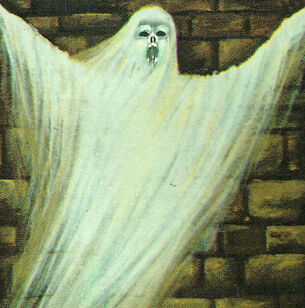No edit summary Tag: Source edit |
m (Reverted edits by JackOKnight (talk) to last revision by Devo DrakeFox) Tag: Rollback |
||
| Line 29: | Line 29: | ||
== Weaknesses == |
== Weaknesses == |
||
*Salt: A Ghost cannot interact with salt. |
*Salt: A Ghost cannot interact with salt. |
||
| − | *Light: Some stories, like |
+ | *Light: In Some stories, like vampires, ghosts are vulnerable to light. |
[[Category:Undead]] |
[[Category:Undead]] |
||
[[Category:Spirits]] |
[[Category:Spirits]] |
||
Revision as of 21:02, 25 September 2021

A ghost is the spirit of a dead person or animal that remains on the mortal plane instead of passing on into the afterlife. It exists in a state between life and death, unable to pass on to the next world and forced to remain anchored to the physical plane, though it cannot necessarily interact with the world around it. Ghosts are still widely believed in today and it is commonly accepted that the reason they stay behind in the mortal realm is because they have some form of unfinished business that must be resolved before the spirit can be put to rest.
Overview
Ghosts are commonly believed to be victims of accidents or murder and remain in the places they were killed, haunting those locations until they resolve whatever business keeps them bound to the mortal world. In many cases, a ghost may not even remember what business it has to complete and is forced to haunt its place of death forever. Ghosts cannot normally interact with the material world; they cannot be seen, heard and cannot touch anything. However, people with strong psychic ability may be able to sense the presence of ghosts and similar apparitions, and may be able to tap into this latent power and communicate with a ghost on some level. Some types of electronic equipment can detect ghosts as well, though usually the presence of ghosts interferes with the functions of machines. Certain animals (especially cats and dogs) are also said to be able to sense a ghost's presence.
Ghosts are often thought to appear as they did in life, though their ghostly form may appear transparent or deathly white. Some accounts of ghosts describe the spirits appearing fully material, but they appear to bare whatever injuries resulted in their deaths (eg. a ghost who had been killed by decapitation might have a scar on its neck or may even hold its head in its hands). Less serious depictions of ghosts in modern media describe them as appearing to be draped in white sheets and hang in the air.
Powers
Ghosts however, do have some abilities of their own. Such as:
- Levitation: Ghosts can fly or hover off the ground.
- Intangibility: Ghosts can pass through solid objects without getting hurt.
- Scary noises: Ghosts make a variety of different sounds, but they’re usually depicted as making a low moaning sound.
- Telekinesis: Ghosts can make objects move by themselves using their mind.
- Invisibility: Ghosts can vanish from sight in an instant.
- Shapeshifting: Ghosts can sometimes morph into morbidly, gruesomely horrific, grotesque (or amusing) shapes to terrify their haunts.
- Teleportation: Ghost can vanish from one part of the house and appear at another.
- Possession: Some ghosts can take over the body of a living person and operate it like a puppet.
Weaknesses
- Salt: A Ghost cannot interact with salt.
- Light: In Some stories, like vampires, ghosts are vulnerable to light.
